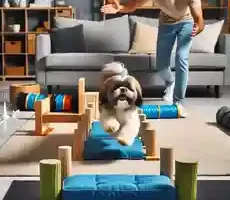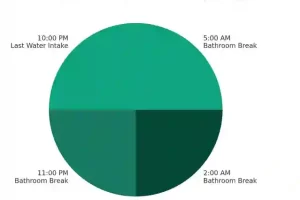How to teach a dog to lay down and stay – Teaching your dog to lay down and stay is a fun and rewarding experience. It helps you and your dog understand each other better.
We will talk about teaching your dog to lay down and stay. Imagine telling your dog to “lay down” and “stay,” and they do it! It’s like magic, right? But guess what? You can do this magic too.
It’s all about fun, treats, and happy times with your dog. We’ll learn how to make your dog listen, follow your commands, and become the best dog they can be.
So, let’s start this fun journey together and turn your dog into a little superstar!
How to Teach a Dog to Lay Down and Stay
Here’s a fun and easy guide to make your dog a champion at these important tricks.
Getting Ready for Dog Training
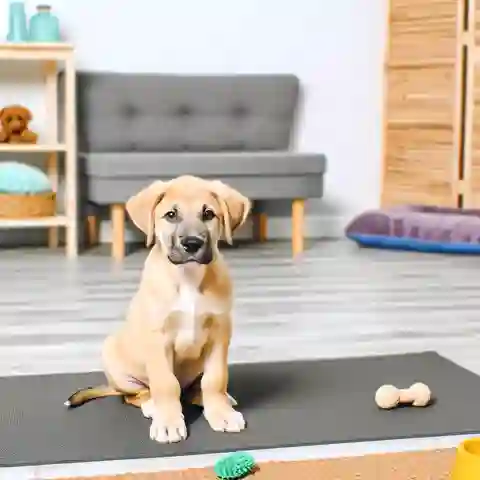
Before you start teaching your dog to lay down and stay, getting ready is a crucial step. Here’s how to ensure both you and your dog are set up for success:
Choose the Right Time
- Pick a time when your dog is not too sleepy but also not overly energetic. After a little playtime is often perfect because your dog might be more willing to focus for treats.
Find a Quiet Place
- Training requires concentration, so find a quiet spot without distractions. This could be a room in your house where your dog feels comfortable and safe.
Gather Your Supplies
- Prepare treats that your dog loves. These should be small, soft, and very tasty—like little pieces of chicken or special dog treats.
- Have a toy ready. Sometimes, toys can be as motivating as treats, especially if your dog prefers play over food.
- Consider a comfortable mat or bed for your dog to lay down on. This can help make the “lay down” command more appealing.
Ensure Your Dog is Ready
- Training should be fun, so make sure your dog isn’t too hungry, thirsty, or needs to go outside. A dog who is comfortable is more likely to focus on you.
- Exercise your dog a little before training. A short walk or some playtime helps burn off excess energy, making your dog more likely to stay focused during training.
Set Yourself Up for Success
- Wear comfortable clothes and be in a positive mood. Your dog can sense your emotions, so if you’re happy and relaxed, your dog will be too.
- Decide on the commands you’ll use ahead of time. Consistency is key, so make sure everyone in your household agrees to use the same words and signals for commands like “lay down” and “stay”.
Plan Your Session
- Know what you want to accomplish in each session. Start with one command at a time to avoid confusing your dog.
- Keep training sessions short. Puppies have short attention spans, so 5 to 10 minutes is often enough.
By getting ready with these steps, you create a positive and effective learning environment for your dog.
Making Training Fun for Your Dog
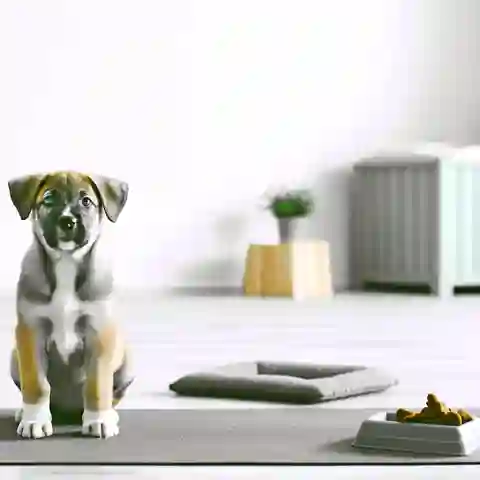
Training your dog should be an enjoyable experience for both of you. When your dog is having fun, they’re more likely to engage with the training and retain what they learn. Here are some ways to ensure training is as entertaining as it is educational:
- Use High-Value Treats
Find out which treats your dog loves the most. These high-value treats should be irresistible and used exclusively for training to maintain their special status. The more your dog looks forward to the treat, the more eager they will be to participate in training.
- Keep Sessions Short and Sweet
Puppies have limited attention spans. Short, 5-10 minute sessions ensure that training doesn’t become tiring or boring. You can have multiple short sessions throughout the day, which is better than one long session.
- Use Playful Voice and Body Language
Your tone of voice and body language play a huge role in how your dog perceives training. Use a cheerful, encouraging tone and lively body language to convey that training time is fun time. This positive energy will be infectious, making your dog excited about learning.
- Incorporate Playtime
Mix in playtime with training. For instance, after a successful “lay down” and “stay,” engage in a short game of fetch or tug-of-war. This not only rewards your dog but also keeps them motivated to participate in training sessions.
- Be Patient and Positive
Always approach training with patience and positivity. If a session isn’t going well, don’t show frustration. Instead, end on an easy command your dog knows well to finish with success and lots of praise. This ensures your dog always associates training with positive experiences.
- Vary the Training Routine
Doing the same thing over and over can become monotonous. Keep things interesting by varying the routine. Work on different commands in each session or change the order of commands. Introducing new tricks once in a while can also keep your dog engaged.
- Celebrate Every Success
No success is too small to celebrate. Whether it’s a perfect “lay down” or just a moment of good focus, reward your dog with treats, verbal praise, and physical affection. Celebrating small victories keeps the training atmosphere light and joyful.
- Take Breaks
If you notice your dog losing interest or becoming distracted, it might be time for a short break. Let them have some water, play, or just relax for a few minutes before trying again. Breaks help prevent frustration and keep training fun.
This approach ensures your dog will always be eager to learn and please, making training a joy for both of you..
Teaching Your Dog to “Lay Down”
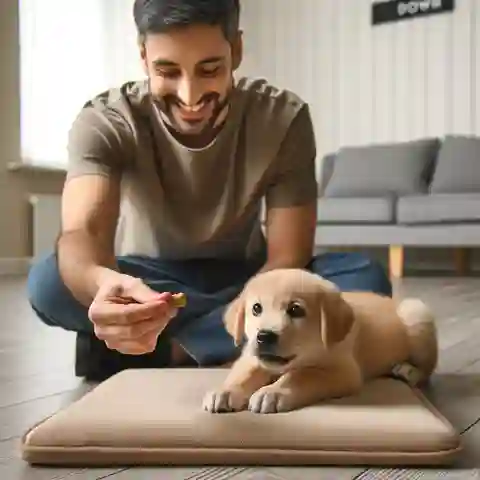
Hey, young friends! Today, we’re going to learn a really cool trick to teach your dog: how to “lay down.” This isn’t just about telling your dog what to do; it’s like learning a secret language together! And guess what? It’s super fun! Let’s dive into the steps to make your dog a “lay down” champion!
Starting Spot
First up, have your dog sit. It’s like the starting line for our fun “lay down” game. If your dog hasn’t learned to sit yet, no worries, you can teach that first!
Treat Trick
Grab a yummy treat and let your dog sniff it but don’t let them eat it yet. Hold it close to their nose, so they’re super interested and want to follow it.
Guide Your Dog Down
Now, slowly move your hand with the treat down to the ground, right between their paws. Your dog’s nose will follow like it’s on a treasure hunt, leading them to lay down. Some folks say moving the treat a little away helps your dog stretch into the lay down position.
Use the Command
As your dog starts lying down, say “lay down” in a clear and friendly voice. It’s like adding a magic spell to the move, so they know what it means.
Celebrate!
The moment your dog’s belly hits the ground, it’s party time! Give them the treat and lots of happy praise. This makes them connect laying down with getting a yummy reward and your happiness.
Practice Makes Perfect
Keep playing this “lay down” game in short, fun rounds. If your dog looks puzzled or bored, take a little break, and then try again. Remember, patience is your superpower here.
Less Hand, More Command
As your dog gets the hang of it, you can start using fewer treats as a guide and more of just the words. But keep the treats coming when they do lay down!
Troubleshooting Common Problems
If your dog stands up or doesn’t lay down right, maybe you’re holding the treat too high or too far. Keep it close to their nose and go straight down to the ground. A soft, cozy spot can also make laying down more inviting.
Positive Reinforcement
Remember, always be kind and gentle. No pushing or forcing. Training is all about making happy memories and building trust with your dog.
It’s all about teamwork, treats, and tons of praise. With your patience and these cool steps, your dog will be a “lay down” pro in no time.
Stay Like a Statue
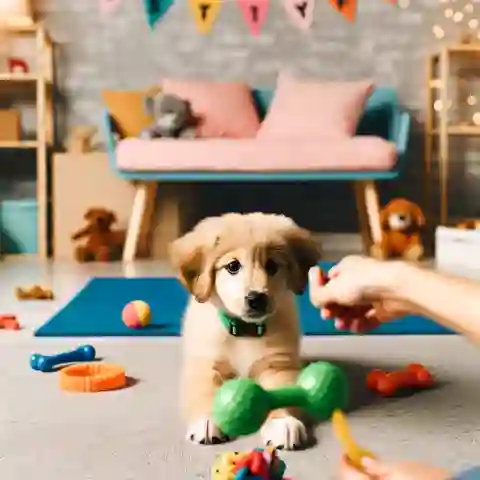
- Palm Out: After your dog lays down, put your hand out like a stop sign and say “Stay” in a clear, calm voice.
- Back It Up: Take a small step back. If your dog stays, it’s treat time again! If not, no worries—practice makes perfect.
- Short but Sweet: Start with just a few seconds, then slowly make the stay time longer. It’s like building up superpowers gradually.
- Freedom: Use a happy word like “Okay!” to let your dog move again. It’s the signal that the superhero can relax now.
Duration of Training Sessions for Your Dog
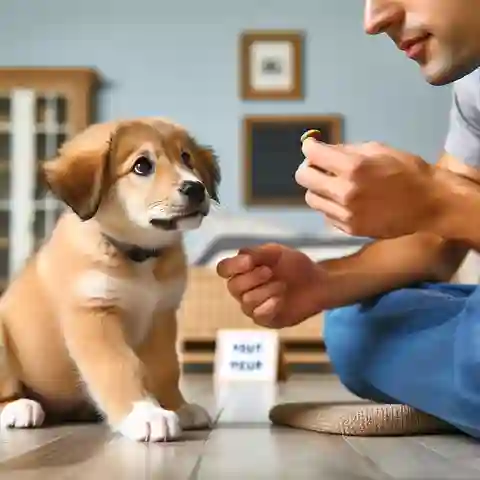
Here’s how to determine the ideal length for your dog’s training sessions:
Keep Sessions Short
Typically, training sessions should last 5 to 10 minutes. This short duration is ideal for keeping your dog focused and engaged without overwhelming or tiring them.
Watch Your Dog’s Behavior
Your dog will give you cues when they’re losing interest or becoming tired. Signs like distracted behavior, lying down, or ignoring commands suggest it’s time to end the session. Always aim to finish before these signs appear to keep training positive.
Quality Over Quantity
It’s more effective to have several short sessions spread throughout the day than one long session. This approach allows for repeated reinforcement of commands and behaviors without exhausting your dog’s attention.
Adjust Based on Age and Energy Level
Younger puppies typically have shorter attention spans than older ones. Start with sessions at the lower end of the 5-10 minute range for very young puppies, gradually increasing as they grow and can focus for longer.
Additionally, a dog’s energy level can affect their ability to concentrate. If your dog is particularly energetic, they might need a bit of playtime before they can focus on training.
Use Positive Reinforcement
Within these short sessions, use positive reinforcement liberally. Treats, praise, and playtime not only reward your dog but also help keep their attention on you and the task at hand.
End on a High Note
Aim to conclude each training session with a success, even if it means reverting to a simpler command your dog already knows well. Ending with positive reinforcement ensures your dog looks forward to the next session.
Consider Your Dog’s Learning Curve
Be flexible with session lengths based on how quickly or slowly your dog is learning. Some days they might be more receptive and able to focus longer, while on other days, they might struggle with attention from the start.
Frequency of Sessions
Aim for multiple training sessions throughout the day. Two to three sessions are ideal for reinforcing learning without overdoing it. This frequent, consistent practice solidifies the behaviors you’re teaching.
Best Ways to Reward Your Dog for Staying in Place
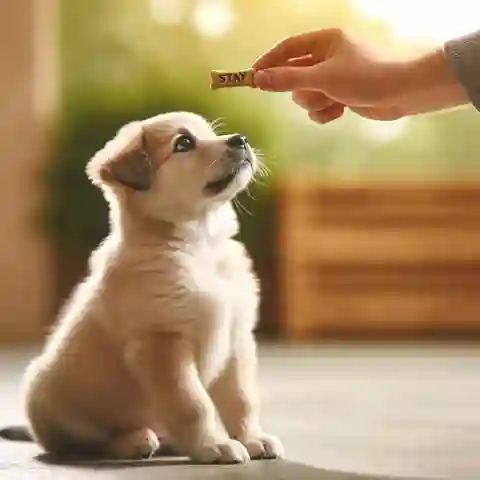
Here are the best ways to reward your dog for successfully staying in place:
Use High-Value Treats
High-value treats are irresistible to your dog and can be a powerful motivator. These are treats that your dog doesn’t get at other times, making them special and highly sought after. Use these sparingly and specifically for rewarding challenging commands like “stay.”
Offer Praise and Affection
Verbal praise and physical affection are also important rewards. A cheerful “Good stay!” followed by petting or cuddles reinforces the behavior through positive attention. Dogs are social animals and value this interaction highly, often as much as or more than treats.
Playtime as a Reward
Ending a successful “stay” command with a short play session can be a fantastic reward. Whether it’s a game of fetch, tug-of-war, or just some free play, this not only rewards your dog but also helps release any pent-up energy from staying still.
Use a Release Word as Part of the Reward
Incorporating a release word to signal the end of the “stay” command turns the act of being allowed to move again into a reward. This teaches your dog that staying put until given permission to break position is a behavior that leads to positive outcomes.
Offer Variety in Rewards
Mixing up the types of rewards keeps training exciting and unpredictable for your dog. Alternating between treats, praise, play, and affection keeps your dog guessing and eager to see what comes next.
Timing is Everything
The timing of the reward is crucial. Reward your dog immediately after they have completed the stay command. This helps them make a clear connection between the behavior and the reward.
Gradually Reduce Food Rewards
As your dog becomes more reliable with the “stay” command, gradually reduce the frequency of treat rewards. Start to rely more on praise, affection, and play as rewards. This transition helps your dog learn to follow commands without always expecting a treat.
Make It a Positive Experience
Every training session, especially for commands as challenging as “stay,” should end on a positive note. Even if your dog struggles with staying in place, find something they did well to reward. This ensures they always associate training with positive outcomes.
Reward Incremental Progress
Especially in the early stages of learning “stay,” reward incremental progress. If your dog manages to stay for even a few seconds longer than before, that’s worth a reward. Acknowledging and rewarding small improvements can lead to big successes over time.
Using Toys Instead of Treats for Training
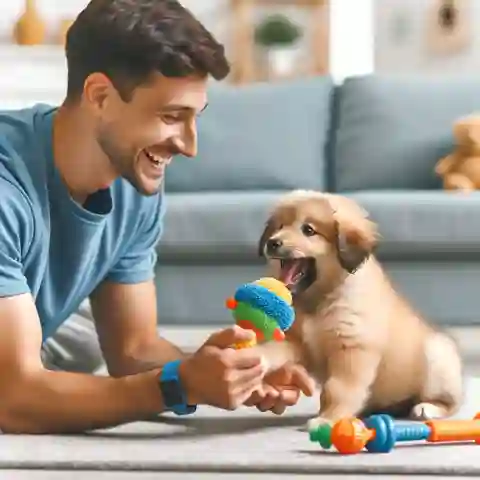
Here’s how to use toys effectively in your training regimen:
Choose the Right Toy
- Identify toys that your dog is particularly fond of. This could be a squeaky toy, a tug rope, or a ball. The toy must be something that excites your dog and can hold their attention.
Use the Toy as a Motivator
- Just like with treats, you can use the toy to encourage your dog to perform a desired action. For example, show your dog the toy before giving a command. Once your dog successfully completes the command, engage in a short play session as the reward.
Implement a ‘Trade’ System
- To prevent your dog from becoming too fixated on the toy and ignoring commands, use a trade system. Ask your dog to perform a command, and then trade their compliance for a short playtime with the toy. After playtime, the toy is put away until the next successful command.
Timing is Key
- As with treat rewards, timing is crucial when using toys as a training incentive.
Short Play Sessions
- Keep play sessions short and sweet, just long enough to be rewarding but not so long that your dog loses interest in training.
- Mixing toys and treats as rewards can provide a balanced approach to training, catering to your dog’s mood and preferences at different times. Some commands may be more effectively reinforced with treats, while others with play.
Focus on the End Goal
- Remember, the ultimate goal is to have your dog respond to commands without needing a physical reward every time. Gradually, you should move towards verbal praise and petting as rewards, with toys and treats used sparingly to reinforce learned behaviors.
Avoid Overstimulation
- Use the toy to enhance focus, not detract from it.
Consistency and Patience
- As with any training method, consistency and patience are key. Your dog may take some time to understand that obeying commands leads to playtime, but with persistence, they will catch on.
Health and Safety
- Ensure the toys used are safe and appropriate for your dog’s size and age. Regularly inspect toys for wear and tear, replacing them as necessary to prevent choking hazards.
Avoiding Common Training Mistakes
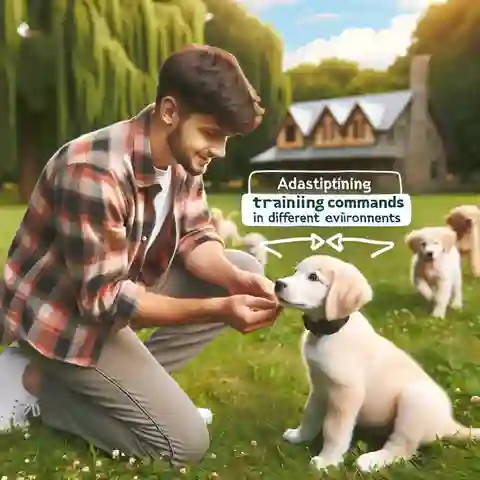
Sometimes, we can make little mistakes without knowing. Here’s how to keep training fun and get better together without those sneaky traps!
Inconsistency
Imagine if “sit” meant “sit” one day and “jump” the next. Confusing, right? Always use the same words and signs for commands. This way, your dog knows exactly what you’re asking. Make sure everyone in the house does the same thing, too.
Negative Reinforcement
Yelling or being mad when your dog gets it wrong can make them scared or sad. They might even be afraid to try new things. Always use happy things like treats and hugs to show them when they do something great. This helps them learn faster and makes training a happy time.
Overloading with Commands
Trying to learn a lot of tricks at once can be too much for your dog. Stick with one command until your dog is really good at it, then start another. This helps your dog feel proud and not mixed up.
Short and Sweet
Puppies can’t pay attention for a long time, just like it’s hard to sit still in class all day. Keep training quick and fun—about 5 to 10 minutes is perfect. You can play these training games a few times a day.
Skipping Practice
Skipping training days can make your dog forget what they’ve learned. Try to practice a little bit every day. It’s like how doing a little homework every night helps you remember for the big test!
Lack of Patience
Sometimes, your dog might not get it right away, and that’s okay! Getting upset won’t help. Remember, learning takes time. Cheer for the good tries and keep practicing. They’ll get there!
Failing to Gradually Phase Out Treats
Treats are awesome for teaching new tricks, but we don’t want your dog to only do tricks for treats. Start saying “good job” or giving belly rubs instead of a treat sometimes. This way, they’ll listen even when you don’t have a treat.
Not Training in Different Environments
Your dog might forget their manners if you only practice at home. Try the same commands at the park or a friend’s house too. It helps them understand that “sit” means “sit” anywhere, not just in the kitchen.
Rewarding Unwanted Behaviors
It’s easy to accidentally say “good job” for something we don’t really want, like jumping up. Make sure you’re only giving treats and cuddles for the behaviors you like.
Delayed Rewards
Imagine doing something awesome and getting a “thank you” an hour later. It’s confusing, right? Give your dog their treat right after they do something good. This way, they know exactly what they did right.
Training is all about having a great time together and learning new things. By watching out for these common oopsies, you and your dog will become an amazing team.
How do you know when your dog has mastered the commands?
Recognizing Mastery of Commands
- Good Anywhere: Your dog is awesome if they can listen to you everywhere – not just at home but outside and in new places too, even with lots of things going on around them.
- Super Quick to Listen: If your dog does what you say right away, without you having to ask over and over, they’re really getting it!
- No Treats Needed: At first, you use yummy snacks or fun toys to get your dog to listen. But if they listen without seeing a treat, they’re a real pro!
- Stays Put for Ages: If you tell your dog to “stay” and they can chill without moving while you walk away or even if they can’t see you, they’ve nailed it!
How can you build on these commands for more advanced training?
Building on Basic Commands for Advanced Training
- Step It Up Slowly: Make things a bit trickier bit by bit. For “stay,” try having your dog wait longer, or you could move farther away before you say it’s okay to move.
- Learn New Tricks from Old Ones: Use easy commands your dog knows to teach them new fun stuff. Like, if they can “lay down,” next, they might learn to “roll over.”
- Mix It Up: Try asking your dog to do a few things one after the other, like “sit,” then “lay down,” and “stay.”
- No Leash? No Problem!: Once your dog is good with a leash, try practicing in a safe place without one. It’s a big step for them to listen to you even when they’re not on a leash.
- Be Nice with New Friends: Teach your dog to be calm and cool when meeting new people or when friends come over.
- Brain Games and Gym Time: Try fun activities that make your dog think and move, like obstacle courses or toys that give treats when they figure them out.
- Know the Difference: Help your dog learn different words for different things. It’s like learning that “sit” isn’t the same as “stay.” They’ll get smarter at knowing exactly what you want!
- Keep Calm and Train On: Sometimes, training takes time. Every dog learns at their own speed. Always be patient and keep training fun.
- Never Stop Learning: Even when your dog knows a bunch of commands, there’s always something new to learn.
When your dog is a training star, you can teach them even cooler tricks and have the best time together!
In conclusion, We’ve learned so much together about how to teach a dog to lay down and stay. It is really fun and easy if we keep practicing.
Remember, it’s about patience, using yummy treats or fun toys, and celebrating every little win with your dog.
The more you practice, the better your dog will get at the following commands. And remember, if things don’t go right the first time, it’s okay. Just try again and keep smiling. Soon, your dog will be doing “lay down” and “stay” like a pro!


